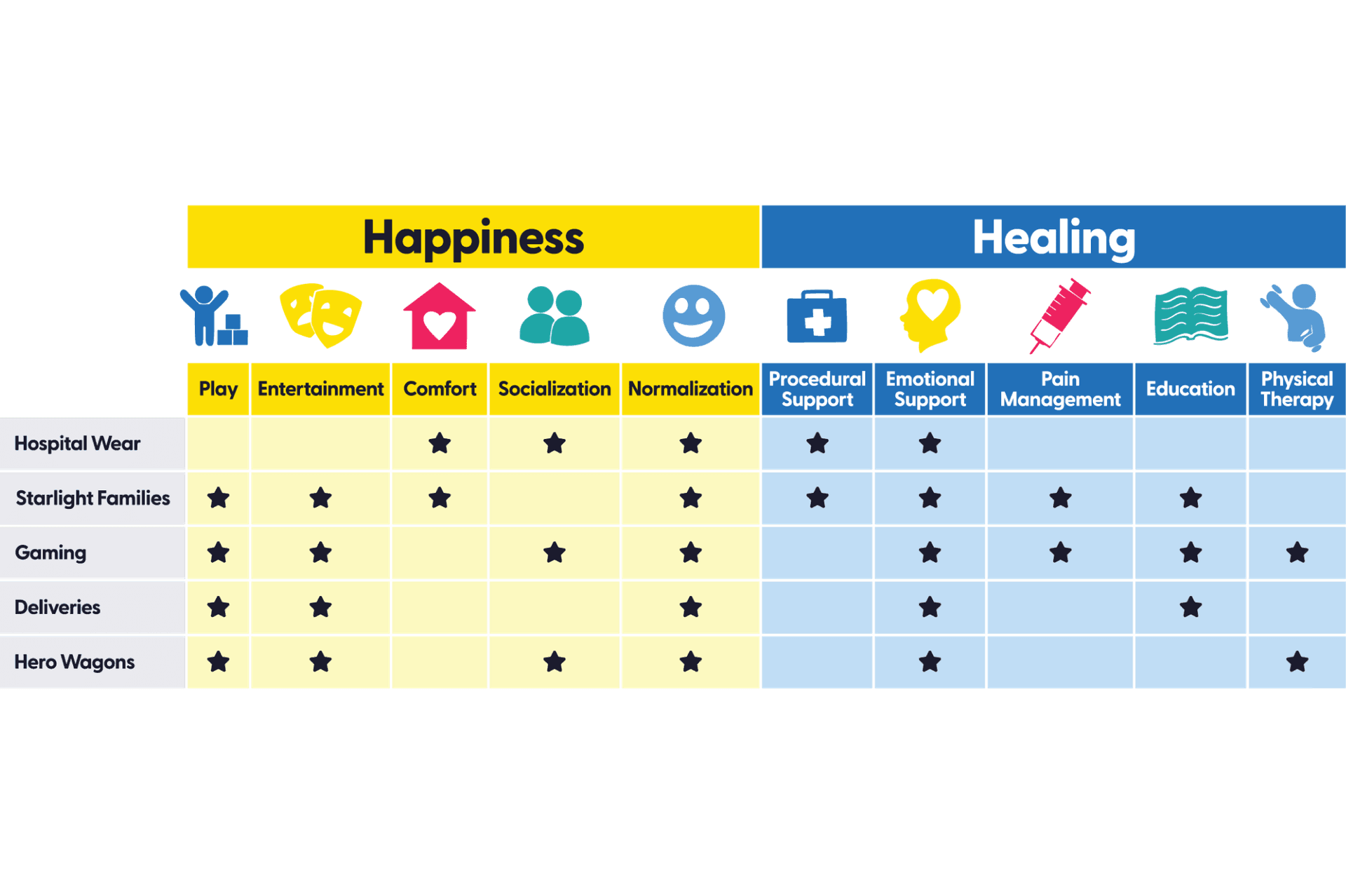Measuring Impact
Learn how we evaluate and measure the impact of each Starlight program.
We understand that it's not enough to simply create and distribute our programs; it's essential to assess their impact to ensure they are effective and meaningful. That's why we take assessing our program's impact seriously, and we'd like to share how we do it.
First, we have defined 10 criteria, spanning Happiness and Healing that we evaluate the impact of each of our programs which is shown in the table below. This allows us to track progress and determine whether we're meeting the objectives of the program.

Next, we collect data to evaluate the impact of our programs. We use a variety of methods, including surveys, interviews, focus groups, and data analysis, to gather information on program outcomes and overall effectiveness.
We analyze the data collected, looking for trends and areas of improvement. We identify what worked well and what didn't, and we make necessary adjustments to improve the program's effectiveness. This process is ongoing, and we continuously assess our programs to ensure we're making a positive impact on the seriously ill children we serve.
Happiness and Healing Pillars

Play
An important part of child development, play helps children to learn, grow, express themselves, and feel safe in an unfamiliar environment. Play is a highly interactive experience that directly engages children through either structured activities (e.g., games that require children to follow a set of rules and norms) or unstructured ones (e.g., “free time”). While it may appear that children engage in play strictly for self-amusement, play also provides happiness through critical behavioral, social, and motor rewards.

Entertainment
Entertainment, such as films, television programs, and streaming media, as well as other types of content, delivers happiness by providing children with content that is enjoyable, amusing, educational, and stimulating to watch. Largely passive experiences (as opposed to “play” which is more active), entertainment often provides children a much-needed sense of relief, and distraction, especially for those in stressful situations.

Comfort
Comforting experiences can help alleviate a child’s feelings of distress and anxiety by creating a sense of physical, mental, and emotional ease, freedom, and security which leads to happiness.

Socialization
When children are given the opportunity to engage with others around them, they’re allowed – and encouraged - to share their opinions, thoughts, and feelings, through words and body language which helps them connect with one another and see themselves as part of a community. This sense of either belonging to a social group and/or understanding themselves as unique and special creates feelings of happiness.

Normalization
In a typical hospital setting, normalization refers to a process or set of experiences that a child recognizes as “normal” to their everyday life outside of the hospital. Normalization is important because it allows for an unfamiliar and often scary place, such as a hospital, to have structure, familiarity, and security.

Procedural Support
It’s important for health care professionals to create a coping plan to help children get through difficult procedures such as IV placement, dressing change, and port access. The coping plan can frequently include redirective focus which encourages the child to get their mind off of the medical procedure by focusing on an experience which makes them happy and thus comply with the procedure in a more positive and successful manner.

Emotional Support
Children require special support to ensure they have an outlet for their emotions, whether its gratitude, pleasure, inspiration, curiosity or love to help ease fear and anxiety around treatments, conditions, environmental stressors, and sometimes grief.

Pain Management
Pain management offers a variety of methods to prevent, reduce, or stop pain sensations. In hospital setting, this can be achieved through psychological as well as physical or pharmacological methods.

Education
In order to successfully manage and cope with either a temporary or long-term treatment plan including frequent or long hospital stays, sometimes in isolation, children (and their caregivers) require developmentally appropriate educational tools related to their specific diagnosis, procedures and medication.

Physical Therapy
A planned program of activities is often prescribed by physicians to help improve a child’s movement or manage their pain. Completing regular routines such as physical exercises often rewards children with a sense of accomplishment and happiness
At Starlight, we're committed to transparency, and we provide regular updates and reports to our donors, and partners demonstrating how their contributions are making a difference.